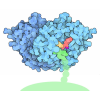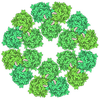+ Open data
Open data
- Basic information
Basic information
| Entry | Database: PDB / ID: 6k71 | |||||||||
|---|---|---|---|---|---|---|---|---|---|---|
| Title | eIF2 - eIF2B complex | |||||||||
 Components Components |
| |||||||||
 Keywords Keywords | TRANSLATION / Translation Initiation | |||||||||
| Function / homology |  Function and homology information Function and homology informationmale germ cell proliferation / regulation of translation in response to endoplasmic reticulum stress / translation initiation ternary complex / glial limiting end-foot / HRI-mediated signaling / response to kainic acid / Cellular response to mitochondrial stress / eukaryotic translation initiation factor 2B complex / response to manganese-induced endoplasmic reticulum stress / positive regulation of type B pancreatic cell apoptotic process ...male germ cell proliferation / regulation of translation in response to endoplasmic reticulum stress / translation initiation ternary complex / glial limiting end-foot / HRI-mediated signaling / response to kainic acid / Cellular response to mitochondrial stress / eukaryotic translation initiation factor 2B complex / response to manganese-induced endoplasmic reticulum stress / positive regulation of type B pancreatic cell apoptotic process / negative regulation of translational initiation in response to stress / Response of EIF2AK1 (HRI) to heme deficiency / Recycling of eIF2:GDP / PERK-mediated unfolded protein response / methionyl-initiator methionine tRNA binding / PERK regulates gene expression / regulation of translational initiation in response to stress / eukaryotic translation initiation factor 2 complex / cytoplasmic translational initiation / translation factor activity, RNA binding / protein-synthesizing GTPase / guanyl-nucleotide exchange factor complex / formation of translation preinitiation complex / oligodendrocyte development / astrocyte development / eukaryotic 48S preinitiation complex / astrocyte differentiation / regulation of translational initiation / Formation of the ternary complex, and subsequently, the 43S complex / Ribosomal scanning and start codon recognition / Translation initiation complex formation / Response of EIF2AK4 (GCN2) to amino acid deficiency / mitophagy / GTP hydrolysis and joining of the 60S ribosomal subunit / L13a-mediated translational silencing of Ceruloplasmin expression / positive regulation of translational initiation / response to glucose / ovarian follicle development / stress granule assembly / translation initiation factor binding / response to endoplasmic reticulum stress / myelination / translation initiation factor activity / cellular response to amino acid starvation / guanyl-nucleotide exchange factor activity / hippocampus development / central nervous system development / translational initiation / ABC-family proteins mediated transport / PKR-mediated signaling / response to peptide hormone / cytoplasmic stress granule / male gonad development / cellular response to UV / ribosome binding / regulation of translation / T cell receptor signaling pathway / cellular response to heat / cellular response to oxidative stress / response to heat / in utero embryonic development / cadherin binding / positive regulation of apoptotic process / GTPase activity / mRNA binding / synapse / GTP binding / mitochondrion / RNA binding / extracellular exosome / ATP binding / identical protein binding / membrane / nucleus / metal ion binding / plasma membrane / cytosol / cytoplasm Similarity search - Function | |||||||||
| Biological species |  Homo sapiens (human) Homo sapiens (human) | |||||||||
| Method | ELECTRON MICROSCOPY / single particle reconstruction / cryo EM / Resolution: 4.3 Å | |||||||||
 Authors Authors | Kashiwagi, K. / Yokoyama, T. / Ito, T. | |||||||||
| Funding support |  Japan, 2items Japan, 2items
| |||||||||
 Citation Citation |  Journal: Science / Year: 2019 Journal: Science / Year: 2019Title: Structural basis for eIF2B inhibition in integrated stress response. Authors: Kazuhiro Kashiwagi / Takeshi Yokoyama / Madoka Nishimoto / Mari Takahashi / Ayako Sakamoto / Mayumi Yonemochi / Mikako Shirouzu / Takuhiro Ito /  Abstract: A core event in the integrated stress response, an adaptive pathway common to all eukaryotic cells in response to various stress stimuli, is the phosphorylation of eukaryotic translation initiation ...A core event in the integrated stress response, an adaptive pathway common to all eukaryotic cells in response to various stress stimuli, is the phosphorylation of eukaryotic translation initiation factor 2 (eIF2). Normally, unphosphorylated eIF2 transfers the methionylated initiator tRNA to the ribosome in a guanosine 5'-triphosphate-dependent manner. By contrast, phosphorylated eIF2 inhibits its specific guanine nucleotide exchange factor, eIF2B. To elucidate how the eIF2 phosphorylation status regulates the eIF2B activity, we determined cryo-electron microscopic and crystallographic structures of eIF2B in complex with unphosphorylated or phosphorylated eIF2. The unphosphorylated and phosphorylated forms of eIF2 bind to eIF2B in completely different manners: the nucleotide exchange-active and -inactive modes, respectively. These structures explain how phosphorylated eIF2 dominantly inhibits the nucleotide exchange activity of eIF2B. | |||||||||
| History |
|
- Structure visualization
Structure visualization
| Movie |
 Movie viewer Movie viewer |
|---|---|
| Structure viewer | Molecule:  Molmil Molmil Jmol/JSmol Jmol/JSmol |
- Downloads & links
Downloads & links
- Download
Download
| PDBx/mmCIF format |  6k71.cif.gz 6k71.cif.gz | 737.1 KB | Display |  PDBx/mmCIF format PDBx/mmCIF format |
|---|---|---|---|---|
| PDB format |  pdb6k71.ent.gz pdb6k71.ent.gz | 592.5 KB | Display |  PDB format PDB format |
| PDBx/mmJSON format |  6k71.json.gz 6k71.json.gz | Tree view |  PDBx/mmJSON format PDBx/mmJSON format | |
| Others |  Other downloads Other downloads |
-Validation report
| Summary document |  6k71_validation.pdf.gz 6k71_validation.pdf.gz | 990.7 KB | Display |  wwPDB validaton report wwPDB validaton report |
|---|---|---|---|---|
| Full document |  6k71_full_validation.pdf.gz 6k71_full_validation.pdf.gz | 1 MB | Display | |
| Data in XML |  6k71_validation.xml.gz 6k71_validation.xml.gz | 115.2 KB | Display | |
| Data in CIF |  6k71_validation.cif.gz 6k71_validation.cif.gz | 177.9 KB | Display | |
| Arichive directory |  https://data.pdbj.org/pub/pdb/validation_reports/k7/6k71 https://data.pdbj.org/pub/pdb/validation_reports/k7/6k71 ftp://data.pdbj.org/pub/pdb/validation_reports/k7/6k71 ftp://data.pdbj.org/pub/pdb/validation_reports/k7/6k71 | HTTPS FTP |
-Related structure data
| Related structure data |  9840MC  9841C  9842C  6jlyC  6jlzC  6k72C M: map data used to model this data C: citing same article ( |
|---|---|
| Similar structure data |
- Links
Links
- Assembly
Assembly
| Deposited unit | 
|
|---|---|
| 1 |
|
- Components
Components
-Translation initiation factor eIF-2B subunit ... , 5 types, 10 molecules ABCDEFGHIJ
| #1: Protein | Mass: 33754.148 Da / Num. of mol.: 2 Source method: isolated from a genetically manipulated source Source: (gene. exp.)  Homo sapiens (human) / Gene: EIF2B1, EIF2BA / Production host: Homo sapiens (human) / Gene: EIF2B1, EIF2BA / Production host:  #2: Protein | Mass: 39039.547 Da / Num. of mol.: 2 Source method: isolated from a genetically manipulated source Source: (gene. exp.)  Homo sapiens (human) / Gene: EIF2B2, EIF2BB / Production host: Homo sapiens (human) / Gene: EIF2B2, EIF2BB / Production host:  #3: Protein | Mass: 50304.230 Da / Num. of mol.: 2 Source method: isolated from a genetically manipulated source Source: (gene. exp.)  Homo sapiens (human) / Gene: EIF2B3 / Production host: Homo sapiens (human) / Gene: EIF2B3 / Production host:  #4: Protein | Mass: 57640.168 Da / Num. of mol.: 2 Source method: isolated from a genetically manipulated source Source: (gene. exp.)  Homo sapiens (human) / Gene: EIF2B4, EIF2BD / Production host: Homo sapiens (human) / Gene: EIF2B4, EIF2BD / Production host:  #5: Protein | Mass: 80466.609 Da / Num. of mol.: 2 Source method: isolated from a genetically manipulated source Source: (gene. exp.)  Homo sapiens (human) / Gene: EIF2B5, EIF2BE / Production host: Homo sapiens (human) / Gene: EIF2B5, EIF2BE / Production host:  |
|---|
-Eukaryotic translation initiation factor 2 subunit ... , 3 types, 3 molecules KMP
| #6: Protein | Mass: 36161.180 Da / Num. of mol.: 1 Source method: isolated from a genetically manipulated source Source: (gene. exp.)  Homo sapiens (human) / Gene: EIF2S1, EIF2A / Production host: Homo sapiens (human) / Gene: EIF2S1, EIF2A / Production host:  |
|---|---|
| #7: Protein | Mass: 38454.484 Da / Num. of mol.: 1 Source method: isolated from a genetically manipulated source Source: (gene. exp.)  Homo sapiens (human) / Gene: EIF2S2, EIF2B / Production host: Homo sapiens (human) / Gene: EIF2S2, EIF2B / Production host:  |
| #8: Protein | Mass: 51178.406 Da / Num. of mol.: 1 Source method: isolated from a genetically manipulated source Source: (gene. exp.)  Homo sapiens (human) / Gene: EIF2S3, EIF2G / Production host: Homo sapiens (human) / Gene: EIF2S3, EIF2G / Production host:  |
-Experimental details
-Experiment
| Experiment | Method: ELECTRON MICROSCOPY |
|---|---|
| EM experiment | Aggregation state: PARTICLE / 3D reconstruction method: single particle reconstruction |
- Sample preparation
Sample preparation
| Component | Name: eIF2 - eIF2B complex / Type: COMPLEX / Entity ID: all / Source: RECOMBINANT |
|---|---|
| Source (natural) | Organism:  HOMO SAPIENS (human) HOMO SAPIENS (human) |
| Source (recombinant) | Organism:  |
| Buffer solution | pH: 7.5 |
| Specimen | Embedding applied: NO / Shadowing applied: NO / Staining applied: NO / Vitrification applied: YES |
| Vitrification | Cryogen name: ETHANE |
- Electron microscopy imaging
Electron microscopy imaging
| Experimental equipment |  Model: Talos Arctica / Image courtesy: FEI Company |
|---|---|
| Microscopy | Model: FEI TECNAI ARCTICA |
| Electron gun | Electron source:  FIELD EMISSION GUN / Accelerating voltage: 200 kV / Illumination mode: FLOOD BEAM FIELD EMISSION GUN / Accelerating voltage: 200 kV / Illumination mode: FLOOD BEAM |
| Electron lens | Mode: BRIGHT FIELD |
| Image recording | Electron dose: 50 e/Å2 / Film or detector model: GATAN K2 SUMMIT (4k x 4k) |
- Processing
Processing
| CTF correction | Type: PHASE FLIPPING AND AMPLITUDE CORRECTION |
|---|---|
| Symmetry | Point symmetry: C1 (asymmetric) |
| 3D reconstruction | Resolution: 4.3 Å / Resolution method: FSC 0.143 CUT-OFF / Num. of particles: 82123 / Symmetry type: POINT |
 Movie
Movie Controller
Controller



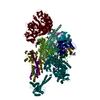


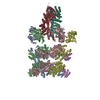
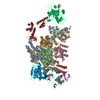


 PDBj
PDBj













